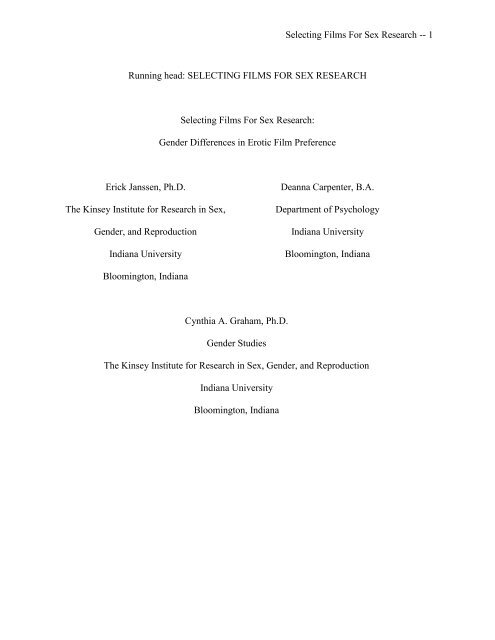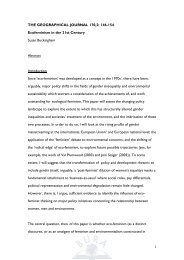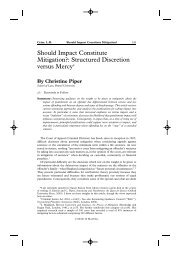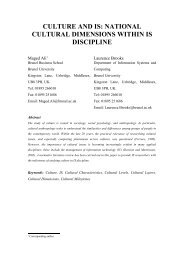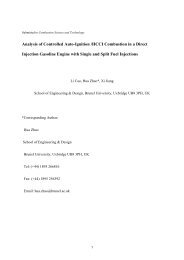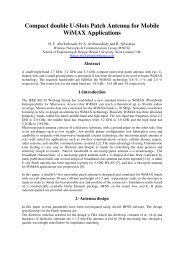You also want an ePaper? Increase the reach of your titles
YUMPU automatically turns print PDFs into web optimized ePapers that Google loves.
<strong>Selecting</strong> <strong>Films</strong> <strong>For</strong> <strong>Sex</strong> <strong>Research</strong> -- 1<br />
Running head: SELECTING FILMS FOR SEX RESEARCH<br />
Erick Janssen, Ph.D.<br />
The Kinsey Institute for <strong>Research</strong> in <strong>Sex</strong>,<br />
Gender, and Reproduction<br />
Indiana University<br />
Bloomington, Indiana<br />
<strong>Selecting</strong> <strong>Films</strong> <strong>For</strong> <strong>Sex</strong> <strong>Research</strong>:<br />
Gender Differences in Erotic Film Preference<br />
Cynthia A. Graham, Ph.D.<br />
Gender Studies<br />
Deanna Carpenter, B.A.<br />
Department of Psychology<br />
Indiana University<br />
Bloomington, Indiana<br />
The Kinsey Institute for <strong>Research</strong> in <strong>Sex</strong>, Gender, and Reproduction<br />
Indiana University<br />
Bloomington, Indiana
Abstract<br />
<strong>Selecting</strong> <strong>Films</strong> <strong>For</strong> <strong>Sex</strong> <strong>Research</strong> -- 2<br />
The aim of this study was to explore gender differences in sexual responsiveness to erotic films<br />
that had been selected for their differential appeal for men and women. A secondary objective<br />
was to identify variables that influence sexual arousal, and explore whether these variables differ<br />
for men and women. Fifteen men (mean age = 26) and 17 women (mean age = 24) were<br />
presented with 20 heterosexual film clips, half of which were selected by female, and the other<br />
half by male, research assistants and were asked to rate the clips on a number of dimensions.<br />
Overall, men found the film clips more arousing than women. Gender differences in arousal were<br />
negligible for female-selected clips but substantial for male-selected clips. Furthermore, men and<br />
women experienced higher levels of sexual arousal to clips selected by individuals of their own<br />
gender. Cluster regression analyses, explaining 77% of the variance for male and 65% for female<br />
participants, revealed that men‟s sexual arousal was dependent upon the attractiveness of the<br />
female actor, feeling interested, and both „imagining oneself as a participant‟ and „watching as an<br />
observer‟. <strong>For</strong> women, with all variables entered, only „imagining oneself as a participant‟<br />
contributed to sexual arousal ratings. The findings suggest that how films are selected in sex<br />
research is an important variable in predicting levels of sexual arousal reported by men and<br />
women.<br />
Keywords: SEXUAL STIMULI; EROTIC FILMS; SEXUAL AROUSAL; GENDER<br />
DIFFERENCES
<strong>Selecting</strong> <strong>Films</strong> <strong>For</strong> <strong>Sex</strong> <strong>Research</strong>:<br />
Gender Differences in Erotic Film Preference<br />
<strong>Selecting</strong> <strong>Films</strong> <strong>For</strong> <strong>Sex</strong> <strong>Research</strong> -- 3<br />
<strong>Research</strong> has demonstrated the effectiveness of erotic films in eliciting sexual arousal and<br />
consistently shown that they induce higher levels of arousal than stories, slides, or fantasy<br />
instructions (Graham, Janssen, & Sanders, 2000; Heiman, 1980; Julien & Over, 1988;<br />
Koukounas & Over, 1997; Laan & Everaerd, 1995a; Smith & Over, 1987). Also, both men and<br />
women report greater arousal in response to explicit sexual stimuli compared to stimuli with<br />
more romantic and less explicit content (e.g., Heiman, 1977; Schmidt, 1975). <strong>For</strong> these reasons,<br />
along with the advantages of being commercially available and easily duplicated, edited, and<br />
standardized, erotic films are widely used in psychophysiological studies on sexual arousal (see<br />
Cranston-Cuebas & Barlow, 1990; Janssen & Everaerd, 1993; Laan & Everaerd, 1995b; for<br />
reviews), orgasm (e.g., Exton et al., 1999, 2001; Rowland & Slob, 1997), sexual preferences and<br />
orientation (e.g., Chivers, Reiger, Latty, & Bailey, 2002, Sakheim, Barlow, Beck, &<br />
Abrahamson, 1985; Steinman, Wincze, Sakheim, Barlow, & Mavissakalian,1981), and sexual<br />
dysfunction (e.g., Berman et al., 2001; Boolell et al., 1996; Janssen, Everaerd, Lunsen, &<br />
Oerlemans, 1994; Meston, 2000; Rowland, Cooper, & Heiman, 1995).<br />
A recurring finding in research using erotic films has been that men and women differ in<br />
their responses to such stimuli. In a meta-analytic review of 46 studies comparing responses of<br />
men and women to sexual stimuli (including films), Murnen and Stockton (1997) concluded that<br />
men reported more arousal than women, although the overall effect size was small to moderate<br />
(d=.31). A number of explanations, reflecting a range of possible social and biological<br />
influences, could account for this finding. To begin with, women may report lower arousal in<br />
response to erotic films as a result of social desirability biases or, conversely, men may over
<strong>Selecting</strong> <strong>Films</strong> <strong>For</strong> <strong>Sex</strong> <strong>Research</strong> -- 4<br />
report their arousal for similar reasons. Alternatively, perhaps because many women in our<br />
culture are aware that erotica exists that is violent or degrading to females, they may have<br />
developed a negative attitude towards sexually explicit films, shaping their responses to them,<br />
even when the films viewed are neither degrading nor coercive. Of course, gender differences<br />
could also reflect the influence of biological factors. Evolutionary psychologists have argued that<br />
men are biologically “wired”, or predisposed to, a greater appreciation of visual sexual stimuli<br />
(Bailey, Gaulin, Agyei,& Gladue,1994).<br />
Another explanation for why men and women differ in their responses to erotic stimuli<br />
has been that most of the available erotica is produced by men for male audiences (Laan,<br />
Everaerd, van Bellen, & Hanewald, 1994). Consistent with this argument, some studies have<br />
found that women do indeed report greater subjective sexual arousal to “women-centered”<br />
stimuli, compared to erotica targeted to men. Heiman (1977) found that women reported higher<br />
levels of sexual arousal to audiotapes that described interactions that were female-initiated (e.g.,<br />
the female was more active than the male in initiating and acting out sexual activities) and<br />
female-centered (e.g., description focused on the female‟s responses, enjoyment, and genitals),<br />
as compared to more male-centered and male-initiated stimuli. More recently, Laan and<br />
colleagues (1994) replicated this finding: women reported significantly more sexual arousal<br />
during the presentation of a woman-made, female-centered erotic film than in response to a<br />
typical mainstream (e.g., man-made, male-centered) film clip. Women also reported more<br />
positive and less negative affect to women-centered films, in comparison with films produced for<br />
a male audience. Interestingly, genital responses to the woman-made and man-made films did<br />
not differ. Mosher and MacIan (1994) found that college-aged women reported more arousal to<br />
woman-made films than to conventional X-rated films. In addition, women in this study reported
<strong>Selecting</strong> <strong>Films</strong> <strong>For</strong> <strong>Sex</strong> <strong>Research</strong> -- 5<br />
experiencing more interest and enjoyment, and less disgust, anger, shame and distress in<br />
response to the woman-made films.<br />
Even in studies that use women-focused erotica, women still tend to report lower levels<br />
of sexual arousal than men. One potentially relevant factor that has not as yet received much<br />
attention is the possible influence of the selection process itself. When published papers do<br />
provide information about how erotic films are selected (which is seldom the case), they have<br />
typically been selected by the researchers. In their meta-analysis, Murnen and Stockton (1997)<br />
did not include any variables related to how or by whom sexual stimuli were selected (e.g., by a<br />
man, a woman, by both, a group of men and women, etc). Yet this information is relevant as it<br />
may partially explain the differences between men and women‟s responses to erotic stimuli.<br />
The primary aim of the present study was to examine gender differences in sexual<br />
responsiveness to erotic films. A secondary objective was to identify variables that influence<br />
sexual arousal, and explore whether these variables differ for men and women. Laan and<br />
Everaerd (1995b) found that the appraisal (i.e., positive or negative evaluation) of erotic stimuli<br />
explained more of the variance in subjective sexual arousal than women‟s level of genital<br />
arousal, age, or experience with erotic films. However, apart from how male- or female-centered<br />
a sexual stimulus is, other factors that may affect appraisal of sexual stimuli in men and women<br />
remain largely unexplored. We looked at how characteristics of film clips (e.g., attractiveness of<br />
actors, setting, soundtrack), as well as how individuals process sexual stimuli (e.g., identify vs.<br />
objectify), might influence appraisal of sexual stimuli.
Participants<br />
Method<br />
<strong>Selecting</strong> <strong>Films</strong> <strong>For</strong> <strong>Sex</strong> <strong>Research</strong> -- 6<br />
Participants were 15 men (mean age=25.6, SD=6.10, range=20-40) and 17 women (mean<br />
age=24.0, SD=4.14, range=19-34) recruited from undergraduate and graduate psychology and<br />
sociology classes. Men and women were not significantly different in age (p>.4). Fifteen<br />
participants were graduate students and 17 were undergraduates. All 15 male participants and 15<br />
of the female participants reported a heterosexual orientation. One woman described herself as<br />
bisexual, and another was “undecided.” The sample was almost exclusively white (94%). Ten<br />
male (67%) and fourteen female (75%) participants reported being currently involved in a<br />
relationship ( 2 =1.1, p>.5). With the exception of one man, all participants (97%) had engaged in<br />
sexual activity with a partner, and all women and 12 men (80%) had experienced vaginal<br />
intercourse. Within the past year, participants reported having engaged in sexual activity (defined<br />
as manual stimulation, oral-genital sex, and/or intercourse) with a mean of 2.1 (SD=1.8) and 1.6<br />
partners (SD= 1.7), respectively. Men and women did not differ in the number of reported sexual<br />
partners. Men, however, reported more frequent masturbation (assessed using a five-point scale<br />
with possible answers ranging from „not once‟ to „four times a week or more‟; 2 = 4.58, p
<strong>Selecting</strong> <strong>Films</strong> <strong>For</strong> <strong>Sex</strong> <strong>Research</strong> -- 7<br />
films individually, and with only two selection criteria: 1) the movies should allow the selection<br />
of three-minute clips that depict consensual heterosexual petting (kissing, genital and nongenital<br />
touching), oral sex, and intercourse between one man and one woman, and 2) they should not<br />
include S&M or other fetishistic activities, nor the use of sex toys such as dildos and vibrators,<br />
etc. Apart from these guidelines, the research assistants were simply asked to select film<br />
segments that they personally found to be highly sexually arousing. This relatively unstructured<br />
protocol was utilized in order to ensure that the selected clips would reflect a range of different<br />
men and women‟s personal preferences.<br />
Both male and female previewers used a number of resources in selecting potential<br />
videos for screening, including recommendations from catalogues (e.g., The Good Vibrations‟<br />
Guide to Adult Videos), websites (e.g., those maintained by “Adult Video News”, “Adam and<br />
Eve”, and “Videogold”), best seller/rental lists at local video stores, and the Kinsey Institute‟s<br />
film collection. Female previewers searched catalogues and the Internet for recommendations of<br />
“women-centered” films. Among these suggestions were the names of several actresses and<br />
directors (including Candida Royalle, Toni English, and Kim Wilde), as well as a few film<br />
production companies (such as Femme) with reputations for producing erotica specifically for<br />
female audiences. Each previewer selected two to eight 5-10 minute film segments, from any of<br />
the above resources, that they personally found to be highly arousing. This process resulted in<br />
32 sexually explicit film clips, 15 chosen by women and 17 by men. The female and male teams<br />
of research assistants then met separately, on one occasion, to view and rate the arousability of<br />
these clips. Clips were viewed in random order. All ratings on the 7-item questionnaire (see<br />
Measures) were independent and anonymous. Following these sessions, the male- and female-<br />
generated unedited film clips were separately rank-ordered using the previewers‟ ratings. Based
<strong>Selecting</strong> <strong>Films</strong> <strong>For</strong> <strong>Sex</strong> <strong>Research</strong> -- 8<br />
on these sexual arousal ratings, the seven clips that the women found most arousing, as well as<br />
the seven clips rated most highly by the men, were selected for the study.<br />
An additional two „male‟ and two „female‟ clips that had been recommended by other<br />
psychophysiological sex researchers were included (female clips #5 and #7 and male clips #11<br />
and #13, see Figure 2), as well as one male and one female clip that had been used in the Kinsey<br />
Institute‟s laboratory (clips #6 and #16). The final 20 clips were edited to control for clip length<br />
and the types of sexual activities depicted. The editing process involved transforming each raw<br />
5-10 minute film segment into a 3-minute clip consisting of 1 minute of kissing and petting, 1<br />
minute of oral sex (preferably both given and received by each partner), and 1 minute of vaginal<br />
intercourse.<br />
The edited clips were presented to participants individually in random order; each clip<br />
was followed by a 2-minute pause to allow for subjective arousal ratings.<br />
Measures<br />
Clip Ratings. The research assistants‟ evaluations of the 32 unedited film clips were<br />
quantified using a 7-item, 10-point Likert-type scale ranging from 1 (not at all) to 10 (very<br />
strongly). Seven dimensions of the film stimuli were rated: the attractiveness of the male and<br />
female actors, as well as how sexually arousing, interesting, repulsive, and male- or female-<br />
oriented they found the clips. The rating sheets also provided a space for other comments about<br />
the clips, although it was specified that providing such additional information was optional.<br />
The participants‟ responses to the 20 edited film clips were measured using an expanded<br />
version of the clip rating form used by the research assistants. In addition to the first five of the<br />
seven items described above, subjects provided ratings on the following 10 dimensions: how<br />
arousing they thought the clips would be for other men and women, to what extent they imagined
<strong>Selecting</strong> <strong>Films</strong> <strong>For</strong> <strong>Sex</strong> <strong>Research</strong> -- 9<br />
themselves as a participant and/or as an observer, how much they identified with the male and/or<br />
female actors, how much attention they paid to the male and/or female actors, and how much<br />
they liked the setting and soundtrack of each clip. This questionnaire also provided space for<br />
comments regarding the most exciting and distracting details of each clip, and what (if anything)<br />
was missing from the clips.<br />
Procedure<br />
Study approval was obtained from the Indiana University Bloomington Campus<br />
Committee for the Protection of Human Subjects. Participants were paid $10. After giving<br />
informed consent, participants were situated in a private, temperature-controlled testing room<br />
furnished with a recliner and a color television monitor. A female experimenter tested the<br />
women, while a male experimenter tested the men. Participants were informed that the purpose<br />
of the study was to select erotic film excerpts that would be used in other Kinsey Institute<br />
research projects and that their participation would involve viewing such film excerpts. They<br />
were assured that all of their responses would be kept strictly confidential, and that they would<br />
have complete privacy for viewing and evaluating the film stimuli. After giving their informed<br />
consent, participants completed the study questionnaire, after which the experimenter left the<br />
testing room and operated the videotape equipment from an adjacent chamber. All instructions<br />
during the video screenings were delivered over an intercom. Following the presentation of each<br />
clip, the experimenter asked the participant to complete a rating form for the video clip just<br />
viewed. Once the participant had completed the ratings, s/he used an intercom signal to cue the<br />
experimenter to begin the next presentation. This procedure was repeated until all 20 clips,<br />
which were presented in random order, had been rated. Following the video screening, the<br />
experimenter debriefed and paid the participants.
Clip Ratings<br />
Results<br />
<strong>Selecting</strong> <strong>Films</strong> <strong>For</strong> <strong>Sex</strong> <strong>Research</strong> -- 10<br />
<strong>Sex</strong>ual Arousal – Self. A 2 (Gender: male, female) x 2 (Clip Type: male, female) mixed<br />
between– and within–subjects ANOVA on the sexual arousal ratings revealed a significant main<br />
effect of Gender, F(1,30) = 10.84, p
<strong>Selecting</strong> <strong>Films</strong> <strong>For</strong> <strong>Sex</strong> <strong>Research</strong> -- 11<br />
arousal (see Table 1). A significant effect of Clip Type was found (F(1,29) = 36.05, p < .0001),<br />
indicating that both men and women believed that the male-selected film clips would lead to the<br />
highest levels of arousal in men. No other main or interaction effects were found.<br />
Men and women also did not differ in their ratings of how arousing the clips would be for<br />
other women (F(1,28) = 1.26, p > .25). In contrast with the estimates for other men, and with<br />
women‟s ratings of their own sexual arousal, no significant effect of Clip Type was found. No<br />
other main or interaction effects were observed.<br />
Predictors of Clip Ratings<br />
Table 2 presents the correlations between the degree of sexual arousal experienced and a)<br />
the participants‟ ratings of a number of clip characteristics and b) how they viewed the film clips.<br />
The majority of correlations were higher in men than in women. [……]<br />
In addition, the correlation between the „participant‟ and „observer‟ items was +.32 in<br />
men (r=-.15 in women). Imagining being a participant while watching the clips was strongly<br />
related to how much one identified with the same-sex actor (men: r=+.88, women: r=+.80) and<br />
the attractiveness of the opposite-sex actor (men: r=+.64, women: r=+.39; these were the highest<br />
intercorrelations for this item). <strong>For</strong> both men and women, watching as an „observer‟ was most<br />
strongly related to how much attention the participants paid to the female actor (men: r=+.64,<br />
women: r=+.42).<br />
______________________<br />
Insert Table 2 about here<br />
______________________
<strong>Selecting</strong> <strong>Films</strong> <strong>For</strong> <strong>Sex</strong> <strong>Research</strong> -- 12<br />
Cluster regression analyses. Instead of using an average or single score for each<br />
participant as our dependent variable, as is done in multiple regression analysis, cluster<br />
regression procedures (Huber, 1967; Rogers,1993) were used to allow the inclusion of all 20<br />
arousal ratings and with these a number of associated variables characterizing each of the 20 film<br />
clips (e.g., attractiveness of the actors, soundtrack, etc.). Cluster regression is a form of multilevel<br />
or hierarchical analysis that takes into account that observations are not independent for a given<br />
individual. This approach was chosen because we were less interested in predicting a<br />
participant‟s average response to film clips than in examining how our predictor variables would<br />
be related to variability in arousal ratings. Because a number of the predictor variables were<br />
interrelated, regression analyses were run in several steps. All twenty arousal ratings were used in<br />
every analysis, but at each step a different set of predictor variables was added.<br />
First, an analysis was run with those variables that most clearly reflected the content or<br />
characteristics of the film clips: attractiveness of the male and female actors, and quality of the<br />
setting and soundtrack. <strong>For</strong> the male participants, 62% of the variance was accounted for, with<br />
only the attractiveness of the female actor reaching statistical significance (ß = +.78; p < .001).<br />
The regression equation for the female participants accounted for 32% of the variance, with<br />
attractiveness of both the male (ß = +.20; p < .001) and female (ß = +.21; p < .003) actors being<br />
positively related to sexual arousal ratings. In addition, the effect of soundtrack quality was<br />
marginally significant (ß = +.13; p < .06).<br />
Next, the two items reflecting aspects of the participants‟ affective responses to the film<br />
clips (the experience of repulsion and interest) were added in a second analysis. <strong>For</strong> males, the<br />
explained variance increased to 69% and both the attractiveness of the female actor (ß = +.67; p <<br />
.001) and feelings of interest (ß = +.35; p < .004) were positively related to the sexual arousal
<strong>Selecting</strong> <strong>Films</strong> <strong>For</strong> <strong>Sex</strong> <strong>Research</strong> -- 13<br />
ratings. <strong>For</strong> women, the repulsion, but not the interest item, turned out to be (negatively) related<br />
to sexual arousal (ß = -.21; p < .02), and this reduced the effect of the female actors‟<br />
attractiveness (ß = +.13; p < .06). The attractiveness of the male actor remained a significant<br />
variable (ß = +.11; p < .01; R 2 = 39%).<br />
Finally, the participant and observer items were added. The explained variance further<br />
increased to 77% for the male participants. In addition to the attractiveness of the female actor (ß<br />
= +.45; p < .001) and feeling interested (ß = +.21; p < .007), imagining oneself as a participant (ß<br />
= +.25; p < .02) and watching as an observer (ß = +.22; p < .006) both contributed to the<br />
regression equation. <strong>For</strong> women, the explained variance increased substantially, to 65%, even<br />
though only one predictor variable was significant: imagining oneself as a participant (ß = +.54; p<br />
< .001).<br />
These last analyses were repeated, but this time separately for the male- and female-<br />
selected clips. Although the general pattern of results remained the same, some interesting<br />
differences were found. <strong>For</strong> the female-selected clips, sexual arousal ratings in men were now<br />
also related to the attractiveness of the male actor, although negatively (ß = -.21; p < .03; R 2 =<br />
77%). <strong>For</strong> women, „feeling interested‟ was an additional predictor of sexual arousal ratings (ß = -<br />
.21; p < .05; R 2 = 62%). The same predictors of male arousal to all 20 clips (reported above),<br />
emerged as predictors of just the 10 male-selected clips.<br />
Individual Variability<br />
To evaluate whether gender differences existed in the variability of arousal ratings,<br />
standard deviations were computed for each individual‟s ratings for the male- and female-<br />
selected clips. While most participants‟ responses had a range of at least 5 and included at least<br />
one rating greater than 5, one female participant gave all 20 clips a rating of either 1 or 2
<strong>Selecting</strong> <strong>Films</strong> <strong>For</strong> <strong>Sex</strong> <strong>Research</strong> -- 14<br />
(resulting in an outlying SD). Excluding this one outlier, a 2 (Gender: male, female) x 2 (Clip<br />
Type: male, female) mixed between– and within–subjects ANOVA was run on the standard<br />
deviations. Both the main effect of Gender (men: mean=1.5; women: mean=2.0; F(1,29) = 8.4,<br />
p
<strong>Selecting</strong> <strong>Films</strong> <strong>For</strong> <strong>Sex</strong> <strong>Research</strong> -- 15<br />
that the clips were standardized for the activities depicted, the amount of time devoted to<br />
foreplay, oral stimulation and intercourse, and the number and gender of actors participating in<br />
each of those activities.<br />
Despite our best efforts to include film clips that would be arousing to a female audience,<br />
women did not report arousal levels comparable to those of the men. Whether this means that<br />
women tend to respond less to visual erotic stimuli than men, or whether other (e.g., social)<br />
factors prevent women from feeling or reporting higher levels of sexual arousal, remains to be<br />
determined. Alternatively, the film selection criteria, which required that all clips depict<br />
heterosexual sexual interactions between one man and one woman, may have limited the<br />
possible range of responses in women. However, the same constraints applied to the male clips;<br />
had we used a more liberal selection procedure, the male assistants might also have located clips<br />
that would have induced higher levels of sexual arousal in men. Koukounas and McCabe (1997)<br />
found that while men showed a preference for scenarios portraying three-somes, women<br />
preferred depictions of vaginal intercourse between a man and a woman.<br />
The largest differences in male and female arousal ratings were found for the male-<br />
selected film clips. No significant gender differences were found for the female-selected clips,<br />
although on average they were associated with lower levels of sexual arousal in men than male-<br />
selected clips. There were some notable exceptions to this finding, with men and women<br />
responding with relatively high levels of sexual arousal to some of the clips selected by<br />
previewers of the other gender (e.g., for women, the second highest arousal rating was for a clip<br />
that was selected by men). But, overall, women, in response to male-selected clips, gave the<br />
lowest sexual arousal ratings.
<strong>Selecting</strong> <strong>Films</strong> <strong>For</strong> <strong>Sex</strong> <strong>Research</strong> -- 16<br />
Genital response measures were not included in the present study because current<br />
psychophysiological instrumentation does not allow comparison of absolute response levels in<br />
men and women (Janssen, 2001). It is conceivable, however, that women and men responded<br />
with equally strong genital responses to the male film clips. In support of this possibility is the<br />
finding by Laan and colleagues (1994) that while women reported significantly more sexual<br />
arousal during the presentation of a woman-made, female-centered erotic film compared with a<br />
man-made, male-centered film clip, their genital responses to the two films did not differ.<br />
Correlations between sexual arousal and ratings of clip characteristics and how the<br />
participants processed them tended to be higher in men than in women. This may be a<br />
consequence of our clip rating measure, which was somewhat limited in scope. Variables<br />
relating to the narrative structure (storyline) or the interaction between the actors might be<br />
important in predicting sexual arousal (perhaps more so for women than for men). These<br />
variables were not included in the present study. Nevertheless, even with our limited predictor<br />
variables, the regression analyses explained comparable amounts of variance in men and<br />
women‟s ratings. <strong>For</strong> men, most of the variance was explained in the first of the cluster analyses,<br />
with the attractiveness of the female actor emerging as the most important predictor; the additive<br />
value of entering more predictors in the analyses for men was minimal. <strong>For</strong> women, the<br />
explained variance increased dramatically after a larger number of variables were included.<br />
In men, both „watching as an observer‟ and „imagining yourself as a participant‟<br />
predicted sexual arousal to the film clips, whereas in women only the latter variable was related.<br />
Apparently, for men „watching as an observer‟ and „imagining yourself as a participant‟ are not<br />
conflicting or incompatible ways of processing a sexual stimulus. Related to this intriguing<br />
finding, for both men and women, watching as an observer was strongly related to how much
<strong>Selecting</strong> <strong>Films</strong> <strong>For</strong> <strong>Sex</strong> <strong>Research</strong> -- 17<br />
attention was paid to the female actor. This suggests that, in contrast to women, the amount of<br />
attention (heterosexual) men allocate to the female actor, the object of their attraction,<br />
contributes to their sexual response independently from the degree to which they feel „pulled‟<br />
into a sexual situation in which a female actor is depicted.<br />
Other researchers have speculated about possible gender differences in the processing of<br />
sexual stimuli. <strong>For</strong> example, Money and Ehrhardt (1972) made a distinction between<br />
„identification‟ and „objectification‟ and hypothesized that the former would be more relevant to<br />
women and the latter to men. According to these authors, when a man watches a woman engaged<br />
in sexual behavior, he will see her as a sexual object and, in imagery, “takes her out of the<br />
picture and has a sexual relationship” (p. 262). A woman, in contrast, would be more likely to<br />
identify with the female actor, such that “she herself becomes the sexual object” (p. 262). Our<br />
results provide only partial support for Money and Ehrhardt‟s distinction; they suggest that<br />
whereas women may indeed be more likely to identify with female actors, men seem equally<br />
likely to „objectify‟ and „identify‟ when presented with visual sexual stimuli.<br />
Although this study revealed some interesting gender differences in the predictors of self-<br />
reported sexual arousal to erotic film clips, it should be emphasized that our understanding of<br />
how sexual arousal is activated in response to sexual stimuli remains cursory. We should be<br />
cautious in inferring any causal relationships between the predictor and outcome variables<br />
explored in this study. While it is possible that the experience of sexual arousal may indeed<br />
depend on the degree to which a viewer feels immersed in a film clip, it is also conceivable that<br />
imagining oneself as a participant in a depicted scene occurs as a result of feeling sexual aroused.<br />
Also, it is tempting to conclude, on the basis of our findings, that imagining oneself as a<br />
participant is a proxy for sexual arousal; Koukounas and McCabe (1997) found similarly high
<strong>Selecting</strong> <strong>Films</strong> <strong>For</strong> <strong>Sex</strong> <strong>Research</strong> -- 18<br />
correlations between feeling „absorbed‟ and sexual arousal. However, this would imply that<br />
feeling immersed in a scene is associated with a specific emotional state. This is unlikely; one<br />
can feel equally immersed in an erotic film or in a thriller, while experiencing different emotions.<br />
The question of whether the experience of feeling immersed is the result of being in a certain<br />
emotional state, or whether they are both the outcome of some other underlying process, is<br />
intriguing. Cognitive, emotion, and psychophysiological studies, as well as the models of sexual<br />
arousal based on them, have pointed to the crucial role of attention in the activation and<br />
modulation of sexual arousal (Barlow, 1986; Dekker & Everaerd, 1988; Geer & Fuhr, 1976;<br />
Janssen et al., 2000, Laan & Everaerd, 1995b). Dekker and Everaerd (1988) found that both men<br />
and women reported stronger arousal during sexual imagery when they paid particular attention<br />
to sexual stimuli, sensations, and physiological responses one might experience in the imagined<br />
situation. Others have shown that distraction, or the allocation of attention away from the sexual<br />
content of a stimulus, whether it is externally (e.g., Geer and Fuhr, 1976) or internally (Barlow,<br />
1986) generated, is detrimental to sexual arousal. However, the factors that determine and<br />
control attentional focus have only begun to be explored (Janssen et al., 2000).<br />
What can we learn from this study about how to best select film clips for sex research?<br />
Our findings suggest that the preferred approach depends on whether one wants to maximize<br />
individual responses or induce comparable levels of subjective sexual arousal in men and<br />
women. Presenting women with film clips initially selected by men will likely lead to lower<br />
levels of sexual arousal, compared with female-selected films, and larger gender differences in<br />
arousal. Therefore, to maximize responses in women, film clips are probably best selected by<br />
women. The recommendation to let same-gender individuals select film clips to induce the<br />
strongest possible responses, seems even more relevant to men, as they responded much stronger
<strong>Selecting</strong> <strong>Films</strong> <strong>For</strong> <strong>Sex</strong> <strong>Research</strong> -- 19<br />
to male- than female selected clips. However, if the goal is to induce comparable levels of<br />
arousal in men and women, it seems more appropriate to have women than men select the films<br />
clips for all subjects (although lower levels of arousal for men than if they were presented with<br />
male-selected films).<br />
Surprisingly little attention has been paid to the selection of films for sex research nor on<br />
how aspects of the erotic film, as well as how they are processed, influence positive or negative<br />
appraisal of the stimuli. Limitations of the current study include the fact that it was a small<br />
sample of young, well-educated volunteers. Our findings suggest that how films are selected in<br />
sex research is an important variable in predicting levels of sexual arousal reported by men and<br />
women.
Concepts Inc.<br />
References<br />
<strong>Selecting</strong> <strong>Films</strong> <strong>For</strong> <strong>Sex</strong> <strong>Research</strong> -- 20<br />
Abascus Concepts (1989). SuperANOVA software for Macintosh. Berkeley, CA: Abacus<br />
Bailey, J. M., Gaulin, S., Agyei, Y., & Gladue, B. A. (1994). Effects of gender and<br />
sexual orientation on evolutionarily relevant aspects of human mating psychology. Journal of<br />
Personality and Social Psychology, 66, 1081-1093.<br />
Barlow, D.H. (1986). Causes of sexual dysfunction: The role of anxiety and cognitive<br />
interference. Journal of Consulting and Clinical Psychology, 54(2). 140-148.<br />
Berman, J. R., Berman, L. A., Lin, H., Flaherty, E., Lahey, N., Goldstein, I., & Cantey-<br />
Kiser, J. (2001). Effect of sildenafil on participative and physiologic parameters of the female<br />
sexual response in women with sexual arousal disorder. Journal of <strong>Sex</strong> and Marital Therapy,<br />
27(5), 411-420.<br />
Boolell, M., Allen, M. J., Ballard, S. A., Gepi-Attee, S., Muirhead, G. J., Naylor, A. M.,<br />
Osterloh, I. H., & Gingel, C. (1996). Sildenafil: an orally active type 5 cyclic GMP-specific<br />
phosphodiesterase inhibitor for the treatment of penile erectile dysfunction. International<br />
Journal of Impotence <strong>Research</strong>, 8, 47-52.<br />
Chivers, M.L., Reiger, G., Latty, E., & Bailey, J.M. (2002). <strong>Sex</strong> differences in the target<br />
specificity of sexual arousal. In preparation.<br />
Cranston-Cuebas, M. A., & Barlow, D. H. (1990). Cognitive and affective contributions<br />
to sexual functioning. Annual Review of <strong>Sex</strong> <strong>Research</strong>, 1, 119-161.<br />
Dekker, J., & Everaerd, W. (1988). Attentional effects on sexual arousal.<br />
Psychophysiology, 25(1):45-54.
<strong>Selecting</strong> <strong>Films</strong> <strong>For</strong> <strong>Sex</strong> <strong>Research</strong> -- 21<br />
Exton, M. S., Bindert, A., Kruger, T., Scheller, F., Hartmann, U, & Schedlowski, M.<br />
(1999). Cardiovascular and endocrine alterations after masturbation-induced orgasm in women.<br />
Psychosomatic Medicine, 61(3), 280-289.<br />
Exton, M. S., Kruger, T. H., Bursch, N., Haake, P., Knapp, W., Schedlowski, M., &<br />
Hartmann, U. (2001). Endocrine response to masturbation-induced orgasm in healthy men<br />
following a 3-week sexual abstinence. World Journal of Urology, 19, 377-382.<br />
Geer, J.H., & Fuhr, R. (1976). Cognitive factors in sexual arousal: The role of<br />
distraction. Journal of Consulting and Clinical Psychology, 44(2), 238-243.<br />
Graham, C., Janssen, E., & Sanders, S.A. (2000). Effects of fragrance on female sexual<br />
arousal and mood across the menstrual cycle. Psychophysiology, 37, 76-84.<br />
Heiman, J. R. (1977). A psychophysiological exploration of sexual arousal patterns in<br />
females and males. Psychophysiology, 14(3), 266-274.<br />
Heiman, J.R. (1980). Female sexual response patterns. Archives of General Psychiatry,<br />
37(11), 1311-1316.<br />
Huber, P. J. (1967). The behavior of maximum likelihood estimation under nonstandard<br />
conditions . Proceedings of the Fifth Berkeley Symposium on Mathematical Statistics and<br />
Probability, 1, LeCam, L. M. and Neyman, J. Editors. University of California Press, pp. 221-<br />
233<br />
Janssen, E. (2001). Psychophysiological measures of sexual response. In M. W.<br />
Wiederman & B. E. Whitley (Eds.), Handbook for conducting research on human sexuality.<br />
Mahwah, NJ: Erlbaum, 139-171.<br />
Janssen, E., & Everaerd, W. (1993). Determinants of male sexual arousal. Annual Review<br />
of <strong>Sex</strong> <strong>Research</strong>, 4, 211-245.
<strong>Selecting</strong> <strong>Films</strong> <strong>For</strong> <strong>Sex</strong> <strong>Research</strong> -- 22<br />
Janssen, E., Everaerd, W., Lunsen, R. H. W., & Oerlemans, S. (1994). Validation of a<br />
psychophysiological Waking Erectile Assessment (WEA) for the diagnosis of male erectile<br />
disorder. Urology, 43, 686-695.<br />
Janssen, E., Everaerd, W., Spiering, M., & Janssen, J. (2000). Automatic Processes and<br />
the Appraisal of <strong>Sex</strong>ual Stimuli: Toward an Information Processing Model of <strong>Sex</strong>ual Arousal.<br />
Journal of <strong>Sex</strong> <strong>Research</strong>, 37(2), 8-23.<br />
Julien, E., & Over, R. (1988). Male sexual arousal across five modes of erotic<br />
stimulation. Archives of <strong>Sex</strong>ual Behavior,17(2), 131-143.<br />
Koukounas, E., & Over, R. (1997). Male sexual arousal elicited by film and fantasy<br />
matched in content. Australian Journal of Psychology, 49(1), 1-5.<br />
Laan, E., & Everaerd, W. (1995a). Habituation of female sexual arousal to slides and<br />
film. Archives of <strong>Sex</strong>ual Behavior, 24(5), 517-541.<br />
Laan, E., & Everaerd, W. (1995b). Determinants of female sexual arousal:<br />
Psychophysiological theory and data. Annual Review of <strong>Sex</strong> <strong>Research</strong>, 6, 32-76.<br />
Laan, E., Everaerd, W., Bellen, G., & Hanewald, G. (1994). Women's sexual and<br />
emotional responses to male- and female produced erotica. Archives of <strong>Sex</strong>ual Behavior, 23(2),<br />
153-170.<br />
Lang, P. J. (1979). A bioinformational theory of emotional imagery.<br />
Psychophysiology,16, 495-512.<br />
Meston, C. M. (2000). The psychophysiological assessment of female sexual function.<br />
Journal of <strong>Sex</strong> Education and Therapy, 25(1), 6-16.
<strong>Selecting</strong> <strong>Films</strong> <strong>For</strong> <strong>Sex</strong> <strong>Research</strong> -- 23<br />
Money, J. & Ehrhardt (1972). Man & woman, boy & girl: The differentiation and<br />
dimorphism of gender identity from conception to maturity. Baltimore, MD: Johns Hopkins‟<br />
University Press.<br />
Mosher, D.L., & MacIan, P. (1994). College men and women respond to X-rated videos<br />
intended for male or female audiences: Gender and sexual scripts. The Journal of <strong>Sex</strong> <strong>Research</strong>,<br />
31(2), 99-113.<br />
Murnen, S.K., & Stockton, M. (1997). Gender and self-reported sexual arousal in<br />
response to sexual stimuli: A meta-analytic review. <strong>Sex</strong> Roles, 37 (3-4), 135-153.<br />
Rogers, W. (1993). Regression standard errors in clustered samples. Stata Technical<br />
Bulletin, 13, 19-23.<br />
Rowland, D. L., Cooper, S. E., & Heiman, J. R. (1995). A preliminary investigation of<br />
affective and cognitive response to erotic stimulation in men before and after sex therapy.<br />
Journal of <strong>Sex</strong> and Marital Therapy, 21(1), 3-20.<br />
Rowland, D.L., & Slob, A.K. (1997). Premature ejaculation: Psychophysiological<br />
considerations in theory, research, and treatment. Annual Review of <strong>Sex</strong> <strong>Research</strong>, 8, 224-253.<br />
Sakheim, D. K., Barlow, D. H., Beck, J. G., & Abrahamson, D. J. (1985). A comparison<br />
of male heterosexual and male homosexual patterns of sexual arousal. The Journal of <strong>Sex</strong><br />
<strong>Research</strong>, 21(2), 183-198.<br />
Schmidt, G. (1975). Male-female differences in sexual arousal and behavior during and<br />
after exposure to sexually explicit stimuli. Archives of <strong>Sex</strong>ual Behavior, 4(4), 353-365.<br />
Smith, D., & Over, R. (1987). Correlates of fantasy-induced and film-induced male<br />
sexual arousal. Archives of <strong>Sex</strong>ual Behavior, 16(5), 395-409.
Corporation.<br />
<strong>Selecting</strong> <strong>Films</strong> <strong>For</strong> <strong>Sex</strong> <strong>Research</strong> -- 24<br />
StataCorp (2001). Stata Statistical Software: Release 7.0. College Station, TX: Stata<br />
Steinman, D. L., Wincze, J. P., Sakheim, D. K., Barlow, D. H., and Mavissakalian, M.<br />
(1981). A comparison of male and female patterns of sexual arousal. Archives of <strong>Sex</strong>ual<br />
Behavior, 10(6), 529-547.
Author Note<br />
<strong>Selecting</strong> <strong>Films</strong> <strong>For</strong> <strong>Sex</strong> <strong>Research</strong> -- 25<br />
We thank Jamie Eisenberg, Jessica Feder, Jennie Finkel, David Goodrich, Matt Hebert,<br />
Amy Lykins, Sean Munnelly, Nicole Prause, Sara Upchurch, and Zoran Vukadinovic for their<br />
help during various phases of the study reported in this paper.<br />
authors.<br />
The titles of the erotic films from which the clips were taken can be obtained from the<br />
Correspondence concerning this article should be addressed to Erick Janssen, The Kinsey<br />
Institute for <strong>Research</strong> in <strong>Sex</strong>, Gender, and Reproduction, Indiana University, Morrison Hall 313,<br />
1165 East Third Street, Bloomington, IN 47405-2501; phone: 812-855-7686; fax: 812-855-8277;<br />
e-mail: ejanssen@indiana.edu.
Table 1<br />
<strong>Sex</strong>ual Arousal Ratings by Film Type and Gender<br />
Male-Selected Clips<br />
Female-Selected Clips<br />
Note.<br />
Women<br />
Sel other<br />
4.41<br />
3.87<br />
<strong>Selecting</strong> <strong>Films</strong> <strong>For</strong> <strong>Sex</strong> <strong>Research</strong> -- 26<br />
Men<br />
5.55<br />
6.56
Imagined Being a Participant<br />
Watched as an Observer<br />
Identified with Actor of Own Gender<br />
Attractiveness of Male Actor<br />
Attractiveness of Female Actor<br />
Attention Paid to Male Actor<br />
Attention Paid to Female Actor<br />
Liked the Clip Setting<br />
Liked the Soundtrack<br />
Interested<br />
Repulsed<br />
Table 2<br />
Correlations Between <strong>Sex</strong>ual Arousal & Other Ratings<br />
Women (N=17)<br />
+.75<br />
<strong>Selecting</strong> <strong>Films</strong> <strong>For</strong> <strong>Sex</strong> <strong>Research</strong> -- 27<br />
+.04*<br />
+.64<br />
+.46<br />
+.44<br />
+.27<br />
+.19<br />
+.42<br />
+.37<br />
+.48<br />
-.40<br />
Note. *All correlations except this one (p>.6) were p


